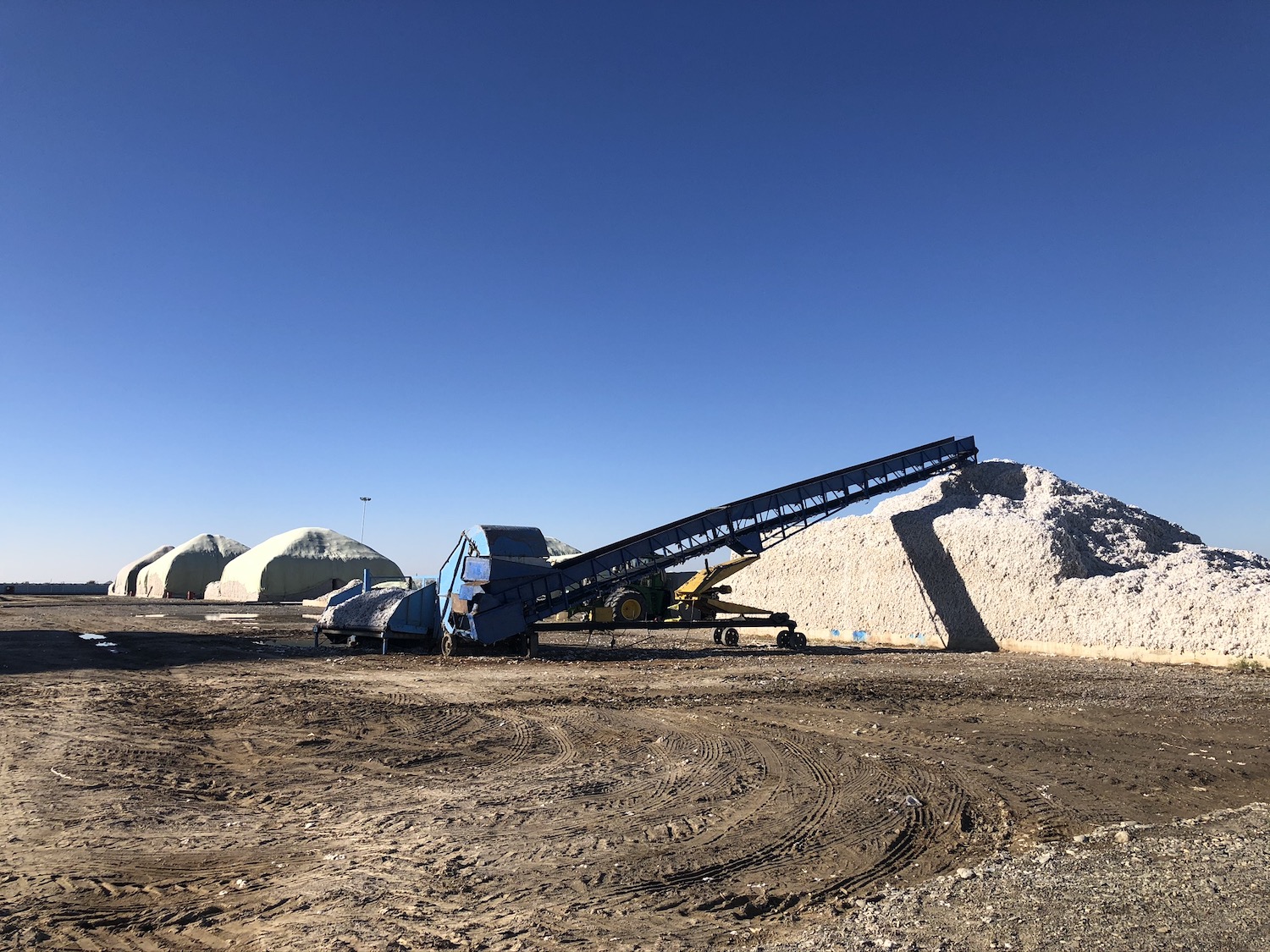
People harvest cotton in a field in Uzbekistan where sustainable cotton farming practices continue to advance.
As the summer months wane, Uzbekistan’s steppes and valleys approach a critical season for the country’s economy, history and culture: the fall cotton harvest. The central Asian nation once accounted for over two-thirds of the Soviet Union’s cotton production. It's still a top global producer of the cash crop, nicknamed oq oltin — which means "white gold" in Uzbek.
Over the course of a century, the country’s cotton sector has undergone dramatic surges, lows and redirections. After Uzbekistan’s independence and under its first president Islam Kerimov’s dictatorship until 2016, the state continued to control cotton production. Nearly 2 million citizens, including children and adults from primarily rural areas, were required to leave school and work to harvest cotton each year for meager or no pay. In 2009, civil activists launched a petition to call on corporations and government entities to boycott Uzbek cotton due to its use of government-mandated labor.
After decades of international, corporate and citizen pressure to reform its labor laws, Uzbekistan is making real improvements. Among the latest developments: In June, key stakeholders and government officials signed on to a sustainability roadmap in partnership with the Better Cotton Initiative (BCI), a nonprofit that works to improve cotton farming practices. The initiative has worked in 26 countries so far, and more than 20 percent of the global cotton supply now meets the Better Cotton standards for environmentally, socially and economically sustainable production.
Over a decade of change in Uzbekistan's cotton industry
BCI launched the Better Cotton Program in Uzbekistan in 2022, a year that marked a major inflection point in the complicated history of Uzbek cotton production.
In 2010, a year after the boycott petition, a human rights watchdog called the Cotton Campaign released a corporate pledge for brands moving away from sourcing Uzbek cotton. Hundreds of global companies, including Adidas, Disney and Macy's, signed it.
The Uzbek Forum for Human Rights — then called the Uzbek-German Forum — also began monitoring and publishing annual reports of cotton farming practices in 2010. Its 2022 report “found no evidence of systematic, government-imposed forced labor for the second consecutive year." The International Labor Organization came to the same conclusion in a report based on 11,000 interviews with farmers.
The Cotton Campaign's corporate pledge subsequently ended in March 2022, reopening the country’s cotton exports to much of the Western market.

Uzbekistan and the Better Cotton Initiative look to scale more sustainable farming practices
Created with key stakeholders, BCI’s roadmap in Uzbekistan is one of the first large-scale plans to transition the country’s farming practices to a more socially and environmentally sustainable model. It highlights four objectives: developing effective management systems, building stakeholder awareness of environmentally sustainable best practices, creating a three-year strategy for management and delivery, and implementing effective, safe labor systems that manage employer-worker relationships.
Better Cotton’s updated principles and criteria will take effect before the 2024-2025 harvest season, and Uzbekistan adopted it as a target national standard, Katerina Gorbunova, Better Cotton’s Uzbekistan manager, told TriplePundit in an email. The criteria’s six principles include management, natural resources, crop protection, fiber quality, decent work and sustainable livelihoods. Two cross-cutting priorities — gender equality and climate change mitigation and adaptation — shape requirements within these areas.
“From a social standpoint, [the new principles and criteria] will place stronger onus on driving impact and promoting wellbeing in farming communities, supported by more robust requirements surrounding decent work and gender equality,” Gorbunova said. “Through ongoing capacity strengthening and check-ins with farm management and trade unions, in partnership with international and local partners, we will focus on strengthening social dialogue and industrial relations aimed to support workers' representation at the cluster level.”
Accounting for historical context
Clusters, or vertically integrated cotton companies, are a key example of how Uzbekistan's recently privatized cotton industry has changed, and continues to change, on a fundamental structural level from its decades-old Soviet model. The previous model employed state farms — where farmers were effectively state employees — and the smaller-scale, but much more common, collective farms called kolkhoz, Russell Zanca, a professor of anthropology at Northeastern Illinois University, told 3p. The kolkhoz structure persisted even after Uzbekistan’s independence, he said, with farms aiming for district harvest targets instead of quotas within the Soviet five-year plans.
But the kolkhoz were not monolithic. “Collective farms could be successful or very poor based on their leadership, objective conditions in terms of area, soil quality… and the degree to which the state paid attention to that particular area,” Zanca said.
Better Cotton’s principles and criteria account for this kind of variation by identifying three categories of farms — smallholders, medium farms and large farms — based on factors like area, structural dependence on permanent labor, and mechanization. All of BCI’s criteria apply to each of these producer categories, but its measurement of their continuous improvement of sustainable practices takes into account that different farms "start at very different baselines." At this point, the initiative's network in Uzbekistan works with large farms.
Cotton farming’s environmental impact
The roadmap is also poised to shift cotton farming’s ecological and environmental impact in Uzbekistan. Some of the primary harmful farming conditions include soil degradation, water supply, pollutants and pesticides, Zanca said.
The Aral Sea, now the Aralkum desert, was the primary 20th-century water source for Uzbekistan’s largely arid land. Salinization, or salty water, affects 63.5 percent of the country’s irrigated land, according to the International Water Management Institute. Outdated irrigation systems are the main cause, and farmers often add more water to the affected land to leach the salt, further straining the water supply. The Aral seabed now poses public health concerns. Its dust carries to surrounding regions and contains not only salt but also fertilizer and pesticide residue, according to the Convention on Biodiversity.
The new criteria’s environmental impact aims include minimizing damage from crop protection, water stewardship, protecting soil health and supporting biodiversity. “A holistic approach to regenerative agriculture supports resilience and builds and nourishes ecosystems,” Gorbunova said. “Many Uzbekistan cotton producers are already incorporating a number of regenerative agriculture practices focused on soil health, biodiversity, the reduction of synthetic inputs, and improved water efficiency.”
Better Cotton’s Roadmap in Uzbekistan has the potential to be a major driving force in shaping more sustainable farming practices — economically, environmentally and socially. When asked about addressing the country’s main agricultural roadblocks, Zanca’s answer felt globally applicable.
“Most people would fall back on the hackneyed, ‘Oh, it's corruption,’” he said. “That, to a degree, is true. But more than that, [we need] accountability — people being informed about what their chances are to increase their income or prosperity if they practice certain measures, or if they change the way they work a little bit.”
Image credit: Helene Bohyn/Better Cotton

Michelle is a freelance writer with experience in international nonprofit work, arts and culture writing, and creative copywriting. She is particularly devoted to stories that highlight cultural expansion and our interdependence.














